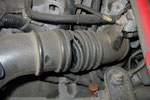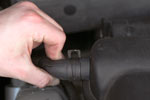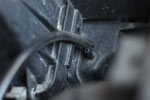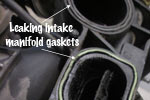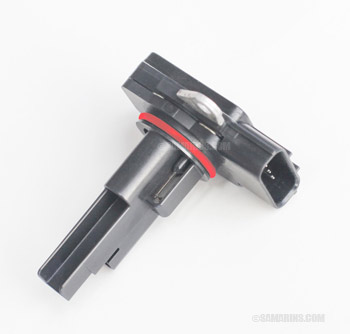Code P0171 - System Too Lean: Symptoms, causes, common problems, diagnostic
By Vlad Samarin, Updated: July 10, 2021
The OBDII trouble code P0171 - System Too Lean (Bank 1) means that the engine air-fuel mixture is too lean, or there is too much air and too little fuel.
Driving a car with the code P0171 can cause more damage to the engine over time, as when the engine runs lean, the combustion temperature is higher. Symptoms:
When an engine runs lean it lacks power and may stall when the car is stopped at a stop sign. The acceleration may also feel slow. The engine may run rough at idle. If this code is caused by a vacuum leak, there might be a hissing noise coming from the engine. Read more about vacuum leaks. The engine may also be difficult to start. Another symptom of an engine running lean is when there is an engine knock or detonation (pinging) under load or when accelerating uphill.Causes:
Common causes include:- Vacuum leaks
- Clogged or faulty Mass Air Flow sensor (MAF)
- Faulty PCV valve or other parts of PCV system
- Faulty oxygen sensor
- Stuck open purge valve/solenoid
- Improperly installed aftermarket intake
- Low fuel pressure
- Clogged-up catalytic converter
Read more: Catalytic Converter: problems, replacement options.
How the code P0171 is diagnosed:
With a good scan tool that shows the live data diagnosing the code P0171 is fairly easy. Without a scan tool, the only way to find the problem is to check the basics and research common problems with your particular car make, year and model. We have done some research and posted common problems for some cars, please read further. The best place to take your car for diagnostics is your local dealer - their technicians are factory-trained and know the common problems with the cars they service.Basic checks under the hood include: is the air filter box properly closed? Does the intake boot have any cracks? Are any of the vacuum lines or hoses disconnected?
What is Intake or Vacuum leak?
An air leak anywhere between the engine intake and the mass air flow sensor is often called a 'vacuum leak' or 'intake leak'. Common examples of vacuum leaks include a ripped or cracked intake boot, leaking intake manifold gaskets, stuck-open or defective PCV valve or ripped PCV hose, cracked or disconnected vacuum line. Read more: Vacuum leaks: common sources, symptoms, repairs. Here are a few examples of intake or vacuum leaks:Common problems causing the code P0171 in different cars:
One way to find a common problem with your make and model is to search for technical service bulletins (TSBs). For example, the Toyota Technical Service Bulletin (TSB) EG045-07 for the 2003-08 Toyota Corolla and Matrix with the 1ZZ–FE engine mentions a leaking intake manifold gaskets in subfreezing temperature as a possible reason for the code P0171 along with some other codes. If the leaking manifold gasket is confirmed following the diagnostic steps, it must be replaced.Many Ford vehicles, including Explorer and F150 had a common problem with leaking gaskets between the upper and lower intake manifolds causing the codes P0171 and P0174. Ford has issued a technical service bulletin on this issue. Another known issue in Ford vehicles is a vacuum leak from a ripped-through rubber elbow on one of the vacuum lines at the back of the intake manifold. Some V6 Mazda vehicles (Tribute, MPV) also have this issue where the rubber elbow at the back of the intake manifold rips through, causing a vacuum leak and the code P0171.
A cracked or ripped intake boot is a common reason for the code P0171 in many BMW vehicles.
Advertisement
Problems with the mass air flow (MAF) sensor causing the code P0171 are fairly common in many vehicles. Sometimes the mass air flow sensor just gets dirty and gives false air flow readings causing the engine to run lean. Cleaning the air flow sensor may help temporarily; the proper repair involves replacing the faulty mass air flow sensor. A mass air flow sensor can be tested with a scan tool; read more here: mass air flow sensor.
Basic car knowledge: how the air/fuel ratio is adjusted
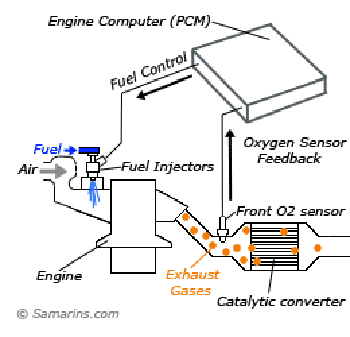 Fuel Trim Control diagram
Fuel Trim Control diagramThe PCM adjusts the fuel supply accordingly to keep the air/fuel ratio at the optimum level, which is 14.7/1 (14.7 parts of air to 1 part of fuel).
This process is continuous: when the oxygen sensor detects too much oxygen, the PCM assumes that the air/fuel mixture is lean and adds more fuel. When there is too little oxygen in the exhaust (air/fuel mixture is rich), the PCM reduces the amount of fuel. In technical language this adjustment is called fuel trim.
What is Fuel Trim?
Short term fuel trim (STFT) Once the front oxygen sensor is warmed up after a cold start, the engine computer (PCM) starts cycling the air/fuel ratio between a little lean and a little rich. This cycling happens around once or twice per second. This air/fuel ratio adjustment is called short term fuel trim (STFT). You can see this cycling on the graph here: air fuel ratio (oxygen) sensor. A typical scan tool displays the STFT as a percentage with "-" or "+" in the Live Data mode. For example, if your car had a small vacuum leak, you would see the STFT going up to + 10-15% at idle and dropping to + 3-5% at higher rpms.Long-term fuel trim (LTFT) There is also a long-term fuel trim (LTFT), which is a long-term compensation of the base air/fuel ratio. For example, if over time, the engine gradually develops a small vacuum leak, it makes the engine run leaner (more air and less fuel). In a long term, the engine computer (PCM) will compensate this condition by adjusting the long-term fuel trim (LTFT) to add more fuel. The long-term fuel trim is also displayed as a percentage with a "-" or "+" sign in a scan tool. For example, a long-term fuel trim (LTFT) at +5% means that the PCM has added some fuel, although 5% is considered within normal range.
How the code P0171 is set
If the air-fuel mixture becomes too lean and the engine computer can no longer compensate for this condition by adding fuel, the engine computer (PCM) turns the "Check Engine" light (MIL) ON and sets the trouble code P0171 - System Too Lean for Bank 1 and (or) P0174 - System Too Lean Bank 2, depending on which cylinder bank is affected. The PCM also stores the freeze frame of the parameters (engine temperature, vehicle speed, fuel trim readings, etc.) at the time when the code was set. Typically, the code P0171 is set when either short term fuel trim (STFT) or long term fuel trim (LTFT) adjustment exceeds a certain value (usually +25%). Read more about the freeze frame.What does the term "Bank 1" mean?
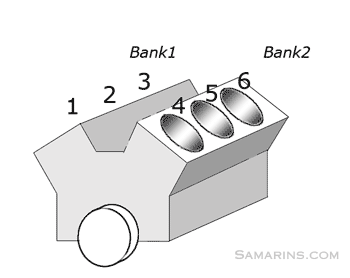 Bank1 and Bank2 in a V6 engine.
Bank1 and Bank2 in a V6 engine.Q: What could cause the code P0171 on 2002 Toyota Corolla? A: In the 2002 Corolla, the code P0171 is often caused by a bad or dirty mass airflow sensor or vacuum leaks. Your mechanic can check for vacuum leaks and test the mass airflow sensor with a scan tool. If the mass airflow sensor is causing the lean condition, cleaning it may help, but usually, it will need to be replaced. There also could be some other reasons, but the air flow sensor and vacuum leaks are the most common.
